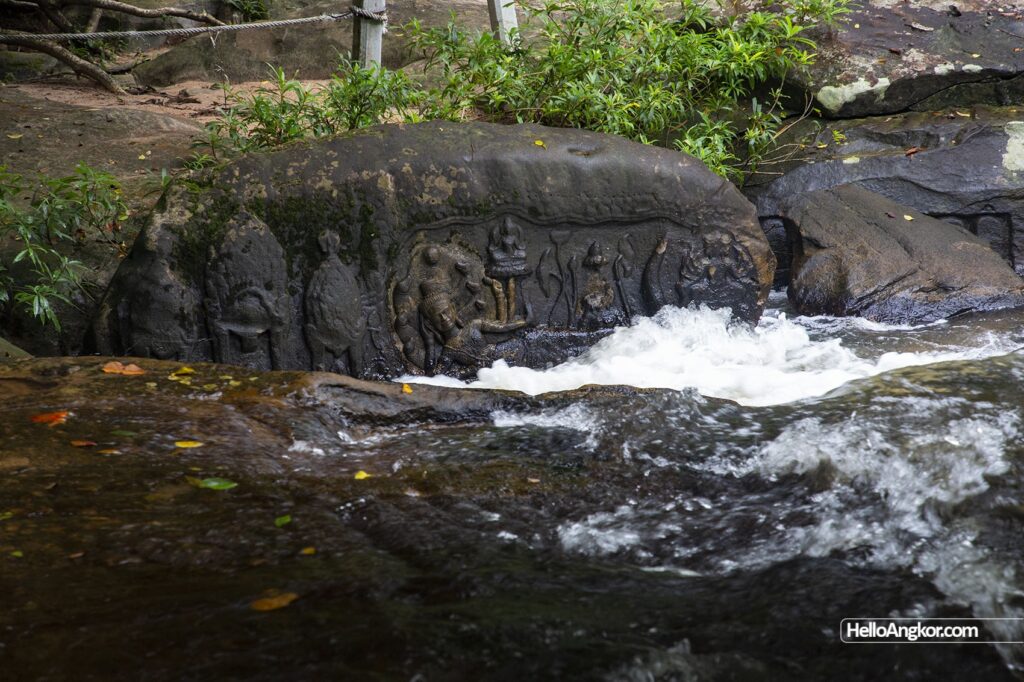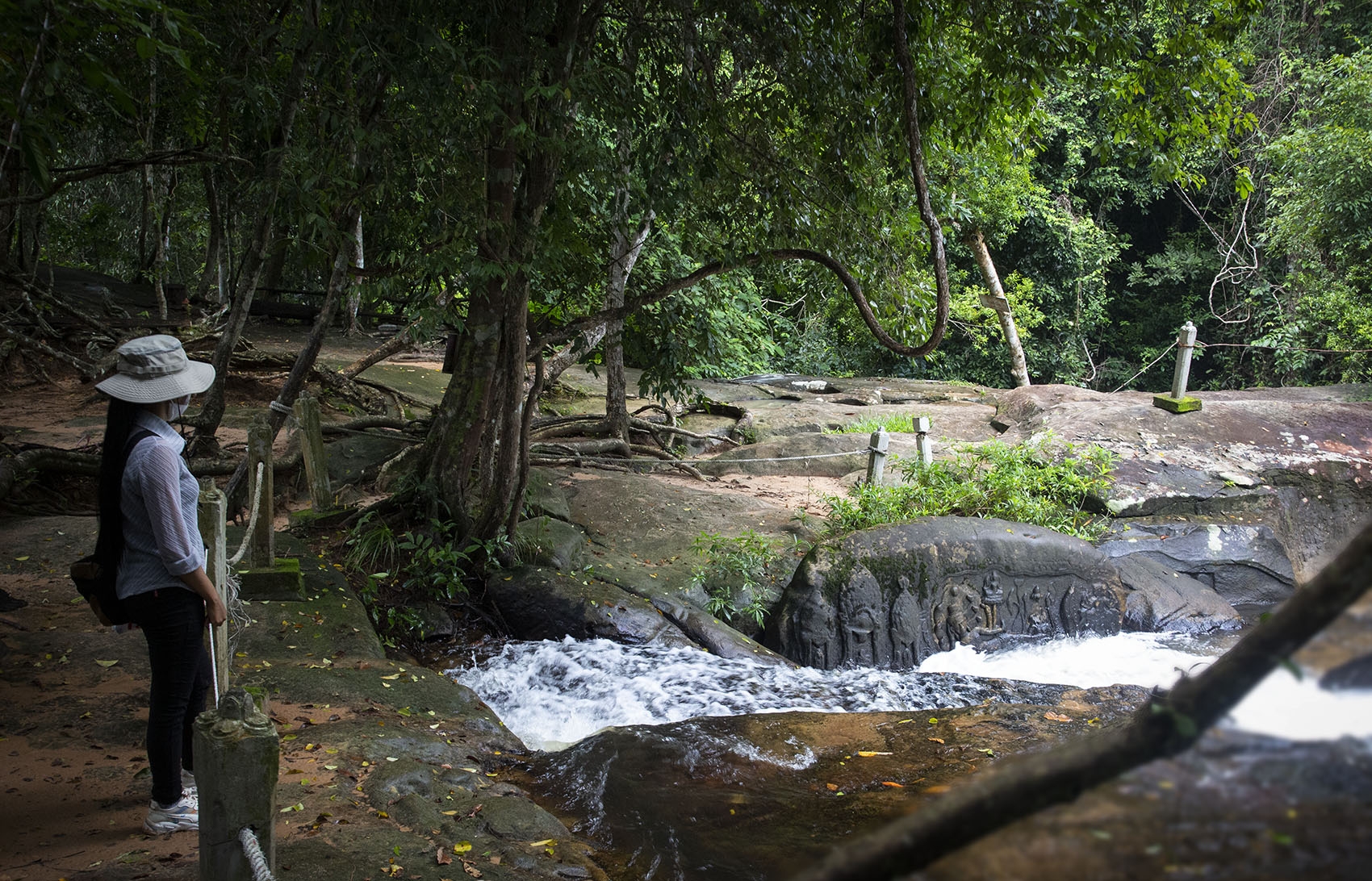The ancient site of Kbal Spean is a section of the river whose waters flow over the natural stone bedrock which has been abundantly sculpted, in particular with linga, but also with gods of the Hindu pantheon including Brahma, Shiva, Vishnu, Uma and other deities. The riverbed even features small basins whose walls were also sculpted. The second half of the site ends in a small but beautiful waterfall.
The river itself is a tributary that flows into the Siem Reap River, feeding the ancient city of Angkor with water sanctified by the reliefs, as it still does to this day.



Visiting Kbal Spean
Located to the northwest of Phnom Kulen, it is around 50 km north of the city center of Siem Reap taking around 60 mins by car and a little longer by tuk tuk or moto, along good sealed roads with enjoyable countryside views along the way.
Once turning off the main road you’ll be on a short dirt trail that leads up to the ticket checkpoint. You can buy water etc. here and there are some Khmer food stalls. From there, it’s around a 40 min walk up to the site via a scenic trail that more or less leads straight to the main site. It’s a natural path that may get a little muddy after rain and the sandstone rocks can become a little slippery, so, appropriate comfortable shoes are recommended.
The trail up, along the river’s carvings, and back down, is quite scenic and enjoyable featuring lots of interesting rock formations, altogether, taking around 3 hours or longer if you so wish. As mentioned suitable shoes are recommended (that said locals walk up in sandals) and you may want to carry a bottle of water as the only drink stalls are at the car park/entrance.
Dry season vs Rainy season – Depending on the extent of the dry season, sometimes there can be little if any water flowing until the rains arrive in late April through to November. The benefit of the dry season is that you get to see what is usually hidden underwater while in the wet season you get the beautiful fast-flowing water over some of the sculptures and the waterfall at the end. There really is no bad time to go.
Kbal Spean opens at 7.30 AM and the last entry is allowed at 3 PM. First thing in the morning is probably the nicest time as it’s a little cooler and less chance of getting caught in an afternoon shower during the wetter months.
Located beside the car park is the Angkor Center for Conservation of Biodiversity (ACCB), and along the way to Kbal Spean you can include visiting Banteay Srey Temple, the Cambodian Landmine Museum and the Butterfly Center at Banteay Srey. You can also take briding tours of the area with Sam Veasna Conservation Tours. Ten minutes north of here via the main road is Khnar Phtoul Temple. There are homestay options in Banteay Srey village and of course, just east of here is Phnom Kulen with its many temples, waterfall, and nature attractions.
History
Fascinatingly, the site wasn’t uncovered until February of 1968 and immediately cleared in the months that followed. The site was initially researched by Jean Boulbet at that same time. According to inscriptions, the site was a hermitage, as are many places across the Kulen plateau, with occupation and carvings at the site attributed to the 11th century and the eras of King Suryavarman I and King Udayadityavarman II.
Layout & Sculptures
The site begins at its northern end where there is a natural stone arch forming a bridge over the shallow river. The carvings begin just north of this bridge and then 150 m or so south with the river winding its way to a waterfall at which the carvings end. Upstream, or north, of the natural bridge you can see a depiction of a Brahma seated on a lotus, a large linga, and lots of small linga. Near the bridge itself, are several depictions of a Vishnu reclining on a hooded Naga in most seen as giving birth to Brahma (seen seated on a lotus rising out of Vishnu’s belly) with his consort, Laksmi at his feet. Beside one of these, three prasats, or temples are depicted. There’s also a relief of Nandin (the bull) carrying Shiva and Uma.
The images that follow are a mix of the dry and rainy seasons, from 2020-2022.



Downstream the linga continue, and more depictions of a reclining Vishnu, giving birth to Brahma once again. According to the report by Jean Boulbet, at one point there is a square basing cut into the bedrock of the riverbed, its inner walls also carved with reliefs, I am yet to witness the water low enough to see this one.



On a rockface opposite, there is a larger depiction of Shiva and Uma riding the bull Nandin. And on the rockface preceding the edge of the waterfall, you can see carvings of devotees, all with different headdresses, plus an ascetic and Ganesha holding a rosary, between these small figures is a large space that once depicted a large standing figure (Krishna or an ascetic?) that has been lost to time, above that, a depiction of a crocodile can still be seen. At the edge of the waterfall, there is a stone shaped into frog/turtle.



Alongside the riverbank, there are also two important and sacred cave/rock shelters, both containing small sandstone pedestals and other fragments, perhaps once being the principal ritual area of the ascetic who created the site. Another ancient pedestal can be seen before taking the stairs down to the waterfall. Also, from the staircase, you can look toward the waterfall and spot one of the inscriptions on a rockface as noted further below.




The waterfall provides a stunning climax and end to the wonderful site.


Inscriptions
There are a number of inscriptions recorded by researchers. A series of inscriptions note a mandarin of king Suryavarman I (reign 1006-1050 AD) coming to retire at a hermitage on Phnom Kbal and making a Sahasrahlinga of Ishvara. It mentions the importance of the site in the eyes of king Udayadityavarman II (reign 1050-1066 AD) and what may be traditional name for the site of Vrah Vila, and also the installation on the mountain of a golden linga. Another inscription relates the river to that of the legendary river Ganga. See the reference listed below for more detail.
- K. 1011 – five short inscriptions located by the large Shiva & Uma on Nandin relief
- K. 1012 – under the waterfall
- K. 1015 – on a rock midstream
- K. 1016 – near the Shiva and crocodile depiction
References and further reading
- Jacques Claude. Les inscriptions du Phnom Kbal Spãn (K 1011, 1012, 1015 et 1016). In: Bulletin de l’Ecole française d’Extrême-Orient. Tome 86, 1999. pp. 357-374.
- Boulbet Jean, Dagens Bruno. Les sites archéologiques de la région du Bhnaṃ Gūlen (Phnom Kulen). In: Arts asiatiques, tome 27, 1973. pp. 3-130.
Map
Site Info
- Site Name: Kbal Spean Khmer Name: ក្បាលស្ពាន
- Reference ID: HA12968 | Last Update: September 17th, 2022
- Tags/Group: 11th Century, Kulen, Map: Top 100 Temples & Ancient Sites (Siem Reap), Phnom Kulen, Temples
- Location: Siem Reap Province > Banteay Srei District > Khun Ream Commune > Khun Ream Village
- MoCFA ID: 1943
- IK Number: 224.43
- Inscription Number/s: K. 1011, 1012, 1015, 1016

